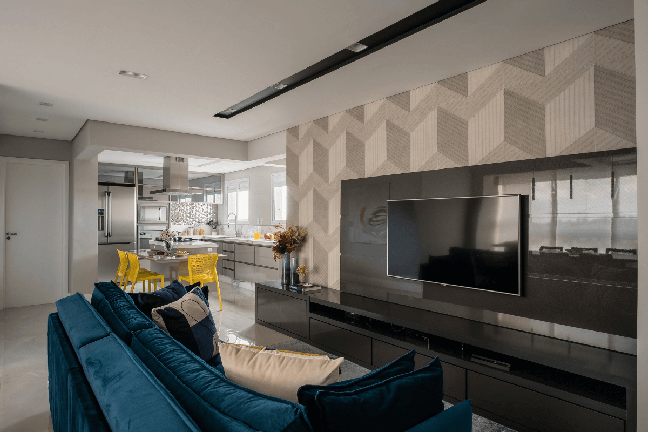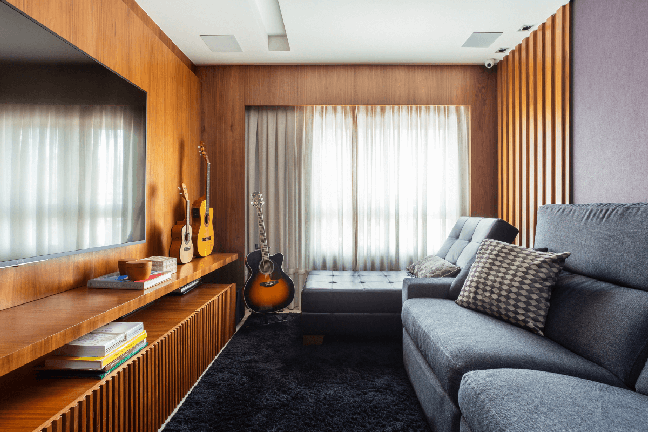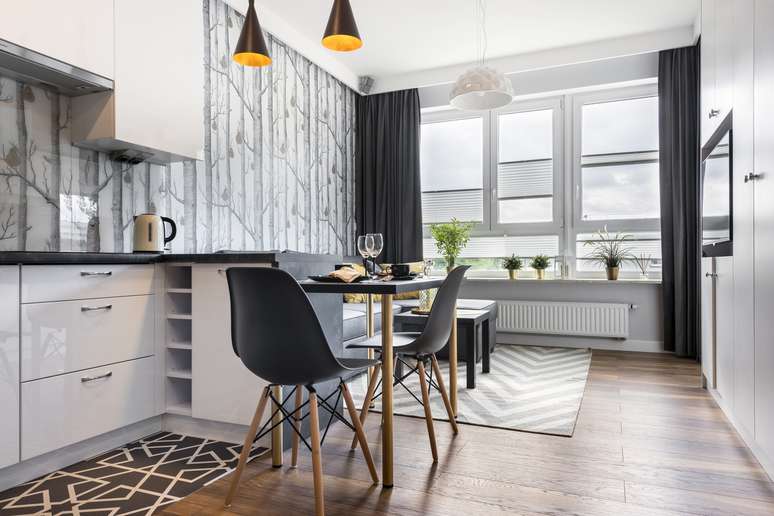Find out how to combine comfort and well-being in a space equipped with screens
Over the years, TV has gained in importance, becoming one of the leading means of communication, information and entertainment in the modern world. Whether to check the programming offered by the television channels or the many options available on streamingthe device is still present in the living rooms and also in the bedrooms.

But how to combine comfort and well-being on these occasions? PB Arquitetura professionals, Cristiane Schiavoni Arquitetura, Dantas & Passos Arquitetura and Patrícia Penna Arquitetura & Interior Design, list the main suggestions they implement in their projects. Watch!
1. Create a relaxing environment
In many projects, when one of the goals is the good division of the rooms your home, creating a TV room becomes essential to separate a specific space of contemplation and relaxation surrounded by the right equipment.
“The living room without a TV is more dedicated to socializing and meeting and, therefore, emphasizes a lighter furniture consisting of sofas, benches and armchairs. The focus of the TV room is always the screen: so our process is to create an environment. conceived with the idea of relaxation – from the arrangement to the definition of the furniture used “, explains Prissioni Tressino.
Two. Consider the size of the TV room
According to professionals, the first step in idealizing the TV room is to evaluate the size of the room, taking into account such aspects as the distance between the sofa and the television, the distribution of electrical points, the use of acoustic equipment and special lighting. .
To be the protagonist of the project, the dimensions of the equipment must be compatible with the area of the environment – both for reasons of harmony between the voices, as well as for visual convenience. “You don’t need to buy a huge device if the space is small. You need to be compatible and respect a certain distance from other objects,” says Bernardo Tressino.
3. Calculate the size of your TV
According to the architects, simple parameters guide the interior architecture. In case of height, it is recommended that the TV axis always be in line with the eyes – considering the height of a person in a sitting position, the references are between 1.20 m and 1.30 m from the floor. In terms of minimum and maximum distance, Prissioni and Bernardo mark the minimum dimensions of 1.5 m and the largest of 2.5 m. But how to make this calculation?
Considering that screens are indicated in inches, it is necessary to convert to centimeters, where 1 inch equals 2.54 cm. Follow the example for a 50-inch TV:
(50 * 1.5) * 2.54 = 190.5cm or 1.90m – in the minimum distance.
(50 * 2.5) * 2.54 = 317.5 or 3.17m – at the maximum distance.

4. Choose comfortable furniture and welcoming
In addition to television, another key direction concerns the selection of complementary items to ensure a comfortable climate. This listing includes a soft, deep sofa that can be even wider to stretch the legs.
“The cozier they are, the better. In small rooms, retractable models respond well to those who have a small room. The version with chaise responds very well to larger proposals, which can be integrated with poufs, used both for seating and as a support for the popcorn bucket “, leads the architect Paula Passos, of Dantas & Passos Arquitetura.
As a key part of the TV room, it is recommended that the sofa be pleasant to the touch, with a higher back and upholstery that “hugs” the user. “The firm sofa is not suitable for this purpose, but for environments designed for the living room”, says architect Danielle.
Colors for fabrics
As for the colors of the fabrics, the indication is to adopt shades on sober tones, which are increasingly easier to match. Complementing a carpet with a pleasant treading touch, adequate lighting, and the inclusion of blackout curtains and blinds to control natural light are very welcome in home theater design with cinematic airs.
5. Choose the right support
In general, racks are mainly used by people who have a lot of devices connected to the TV. But even direct supports on the wall are often seen in masonry and plasterboard structures – the panels are always effective solutions to better hide the wiring without having to break the wall. Suitable for small apartments and integrated environments, the swivel supports optimize space, allowing a television to serve two types of environments.
6. Televisions in the rooms
Not just a living room darling, we can often watch television in dorm designs. The ratio of screen size to bed distance can be the same as in the TV room, but in order for the resident to watch lying down, it must be raised to 1.40m and 1.50m in height.
Television support is generally used, but to define the appropriate model it is necessary to analyze its functionality. “The support can be fixed to the wall, jointed, ceiling and even automated, depending on the specificity of the project. In cases where there is no free wall to hang the TV, it can be installed in a hidden way, with a door integrated into the cladding, or even inside the door of the wardrobe itself, in the carpentry project “, details Priardi Tressino.
By Emilie Guimaraes
Source: Terra
Benjamin Smith is a fashion journalist and author at Gossipify, known for his coverage of the latest fashion trends and industry insights. He writes about clothing, shoes, accessories, and runway shows, providing in-depth analysis and unique perspectives. He’s respected for his ability to spot emerging designers and trends, and for providing practical fashion advice to readers.








